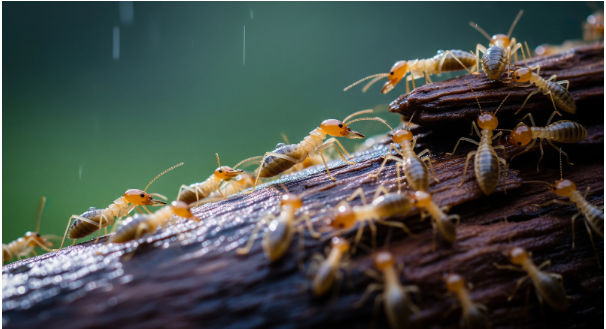The sound of rain might be soothing, but for homeowners, wet seasons bring an unwelcome guest—termites. These destructive pests thrive in moist conditions, making rainy months prime time for infestations. Understanding this seasonal threat can save you thousands in repair costs and protect your home’s structural integrity. Murphy’s Pest Control has helped countless families tackle termite problems before they become costly disasters.
Why Wet Seasons Create Perfect Termite Conditions
Moisture acts like a magnet for termites. During wet seasons, increased humidity levels and standing water create the ideal environment these pests need to survive and multiply. Termites require consistent moisture to maintain their soft bodies and establish colonies.
Rain saturates soil around your home’s foundation, creating damp conditions that attract subterranean termites. These species build mud tubes to travel between their underground colonies and food sources—namely, the wooden structures of your house. Professional pest control in North Richmond experts report significantly higher termite activity during extended rainy periods.
Additionally, wet weather often causes minor leaks in roofs, gutters, and plumbing systems. Even small amounts of moisture trapped in walls or crawl spaces can signal termites that your home offers both food and the water they desperately need.
Warning Signs Every Homeowner Should Recognize
Early detection makes the difference between minor treatment and major structural repairs. Watch for these telltale signs of termite activity:
Mud tubes along exterior walls or foundation areas indicate subterranean termite highways. These pencil-thin tunnels protect termites as they travel from soil to wood sources.
Discarded wings near windowsills, doorframes, or light fixtures suggest reproductive termites (swarmers) have established a nearby colony. Swarmers typically emerge during warm, humid conditions following rain.
Hollow-sounding wood when tapped can reveal termite damage. Termites consume wood from the inside out, leaving thin outer layers that sound hollow when knocked.
Small holes in drywall, along with tiny piles of what looks like sawdust, may indicate drywood termite activity. This “frass” consists of termite droppings and chewed wood particles.
The Hidden Costs of Termite Damage
Termites cause over $5 billion in property damage annually across the United States. Unlike other pest problems, termite damage accumulates silently over months or years before becoming visible.
Structural damage often requires extensive repairs. Floor joists, support beams, and wall studs may need complete replacement if termites have compromised their integrity. Insurance policies typically exclude termite damage, leaving homeowners responsible for full repair costs.
Beyond structural concerns, termite infestations can affect your home’s resale value. Potential buyers often negotiate lower prices or request extensive inspections when termite history exists. Murphy’s Pest Control has seen families face repair bills exceeding $15,000 when termite problems go unaddressed.
Professional Protection and Treatment Options
Murphy’s Pest Control offers comprehensive termite solutions tailored to wet season challenges. Their experienced technicians begin with thorough property inspections, identifying risk areas and existing termite activity using advanced detection tools.
Treatment options include liquid termiticides applied around foundation perimeters, creating protective barriers that eliminate termites on contact. Bait station systems provide ongoing monitoring and colony elimination for long-term protection.
For homes with active infestations, pest control in North Richmond specialists can implement targeted treatments that eliminate entire colonies while preventing future invasions. These treatments often include follow-up inspections to ensure complete eradication.
Simple Steps to Reduce Termite Risk
Smart prevention strategies can significantly lower your home’s termite vulnerability during wet seasons:
Improve drainage around your foundation by cleaning gutters, redirecting downspouts, and grading soil away from your home’s base. Standing water creates termite-friendly conditions.
Eliminate wood-to-soil contact by maintaining proper clearance between wooden structures and ground level. Remove firewood, lumber, and debris stored against your home’s exterior.
Control moisture inside your home using dehumidifiers in basements and crawl spaces. Fix leaky pipes, faucets, and roof areas promptly to prevent attractive moisture buildup.
Schedule regular inspections with qualified professionals. Murphy’s Pest Control recommends annual termite inspections, with additional checks during particularly wet seasons.
Conclusion
Wet seasons create perfect storms for termite infestations, but proactive measures can protect your home and family. Recognition of warning signs, combined with professional prevention strategies, offers your best defense against these destructive pests.
Don’t wait until you discover hollow walls or sagging floors. Contact Murphy’s Pest Control today for comprehensive termite inspection and treatment options. Their expert team understands the unique challenges of pest control in North Richmond and can develop customized solutions for your property’s specific needs. Early intervention saves money, protects your investment, and provides peace of mind throughout every rainy season.






